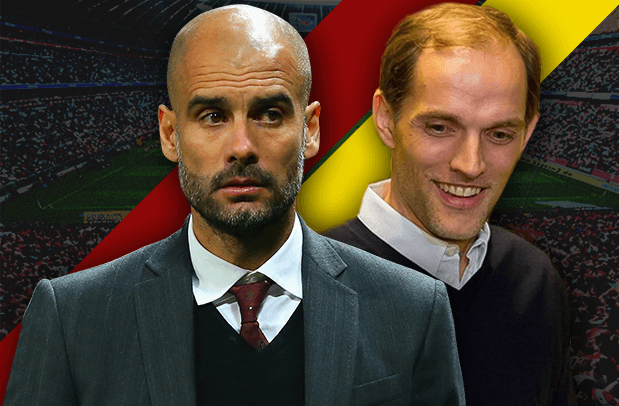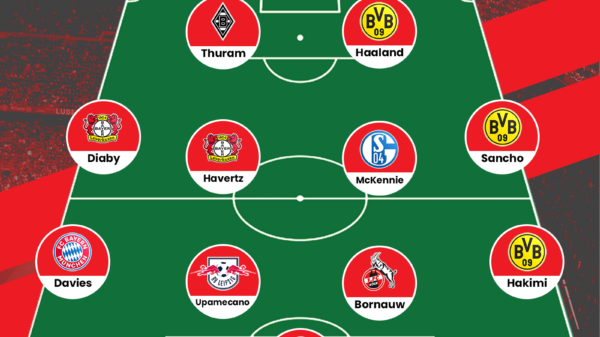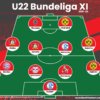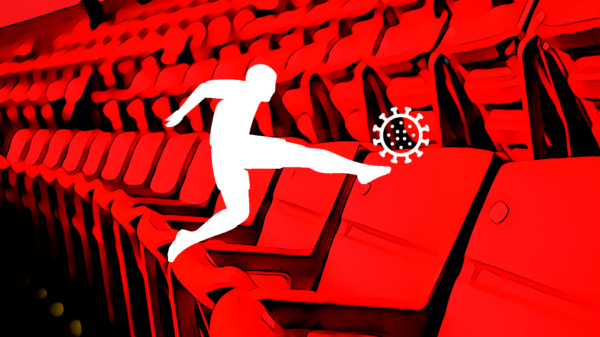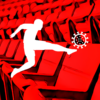The arrival of Josep Guardiola to Bayern München has changed many of the historical conceptions of German football tactics. With his ideology of a short game with possession and game control, in part he revolutionized the functioning of the Bavarian team, dominating the Bundesliga with clear intentions to dominate Europe. But when it seemed that nobody could face it, his rival reborn, Borussia Dortmund has come to the fore with Thomas Tuchel at the controls. We could be seeing the battle which could decide the Bundesliga: Guardiola vs Tuchel.
Therefore, here we will try quickly and synthetically make a comparison of these two ideas, first the possession game of Pep’s Bayern, and then the other direct and vertical play of Tuchel’s BVB.

The combined attack of Bayern München
To begin these are the two formations presented by the Bayern München in the current season 3-4-3 and 4-3-3:

As we all know the Spanish coach has varied his scheme in some of the matches in these first games of the Bundesliga, which marks the first difference with respect to BVB, as the scheme presented by Tuchel in the games so far played has not varied despite him not being able to count on key players as was the case of Marco Reus. Guardiola has played with three and four defenders, subject to availability of some players and his rival. But with both formations, it has carried out the same game plan.
Bayern is known for their orderly attack, attack amplitude, supports and passing lanes as seen in the following picture which shows not just the support but also the amplitude attack. The player on the ball always have a variant on the opposite flank to where the action is being developed as is the case here with Robben, who is alone on the opposite side, the play ended with his goal after a crossed center.

Another characteristic of the team is the possession time. The build ups are usually long with great patience, trying not to give away the ball. Guardiola likes to build the play out from his own goal with the ball under control, combined with short passes.

Here is an example of another characteristic: the diagonal run from infield by as in this case the player marked with black circle (Müller) is located to generate the enabling short game and drag the diagonal markers to liberate the right winger (in this case Douglas Costa). Another important characteristic is the pressure which exerts from the press with the forwards and wingers, which is the first point of pressure. Also the press after losing possession, the quick choking of the rival to recover possession, as is exemplified in the following picture in which a loss in possession is followed immediately by a suffocating pressure exerted over all possible passing lanes of the opponent. The pressure in this situation ends with the recovery and subsequent goal of Douglas Costa.

Guardiola is a coach with a football ideal that values the combination of short passes, where patience and the flow of play is of crucial importance, looking for the best lines from which to assemble the attack and if these are blocked by his rival, his team will try to go back and rebuild starting the entire process again. Therefore it is a scheme of long possession and very good ball control that requires players with great vision, intelligence, precision and control.
Order and progress
Defensively there aren’t often major surprises faced by Pep’s defence, with good marking and organization which makes it complex for any opponent to catch them out. In the images we see two stages, the first counterattack of Bayer not only effectively cut out by the central defender but also by the keeper as Neuer makes ground to cover any gaps in the defensive line, especially when playing with a 3 man defense. In the second image we see the order of the line, plus the coverage of both the right defender defensive midfielder who cuts off any possibility to be surprised by the opponent.


The revival of BVB
BVB are a team that has astonished everyone with their forcefulness, verticality and speed. To begin you must know that Dortmund, unlike Bayern, always use the same scheme, Tuchel chooses a 4-2-3-1 offensive scheme which BVB was already implemented under the mandate of Klopp. The only things that the actual coach varies are the names if necessary such as the entry of Ginter for Piszczek or Hofmann for Reus for example.

Also it is the case of change of responsibilities between Reus and Mkhitaryan depending on how the game develops and the type of defense deployed by the opponent. An experienced defense, the incorporation of young defensive midfielder Julian Weigl who possesses great technique and an outstanding ability to recover possession. Further ahead is Gündogan, who joins the attack frequently to link up with Kagawa and thus has greater capacity to create in the attack. The Japanese International Kagawa is key in this scheme as it enables the diagonals of Reus and Mkhitaryan who can cut diagonally infield to overload the center. The Gabonese forward Aubameyang acts as the focal point of the attack, in turn becoming the first line of defense when exercising pressure on the opponent’s game.
Tuchel’s team is characterized by a very fast, vertical game. With advanced lines, the centre-backs are located almost in midfield when the team attacks, the full-backs are projected forward joining the attack and surprising the opposing defense as seen in the image where Reus takes the ball and Schmelzer goes beyond him enabling a passing option behind the rival defender. They use space, depth and laterals well. The lateral backs and wings operate like Rooks and Bishops, using chess terms. Triangulations are key in the scheme of BVB. Geometrically perfect, often they manage to enable line play by forming triangles wherein two of its three vertices are available, thanks in part to training methods of Tuchel who prepares his teams in smaller pitches, which requires players to adapt to limited spaces and always stay close. This promotes play characterized by speed and precision, a perfect direct game as shown in the picture where you see clearly the passing lanes that form a triangle.

All the attackers are connected by triangulation, in this case Reus is marked in yellow as he will spin in behind and take advantage of the space left by his defender behind his back. The idea of the direct, triangular Tuchel game is to always try to place players ahead of the line of the ball, thus creating lanes and passes that quickly take advantage of this. In the next image we see how the team is standing on a fast attack, where the defense has stepped up to the midfield. Hummels, Sokratis and Weigl generate a triangle. Gündogan (blue) joins in with the attack to support Kagawa and the three red arrows (Hofmann, Aubameyang and Mkhitaryan in this case) exploit space behind the last line of the rival team.

Defensive suffering
At this juncture, everything is beautiful in the life of Borussia Dortmund. However, we will show what happens when the pressure fails, when the opponent manages to elude the press and players generate an attack or a counterattack to catch the defense in midfield. This happens when trying to play an offside trap. Tuchel’s defense is mostly in midfield, trying to make full use of the offside trap to annul rival counterattacks, but with diagonal play and good tempo, this method may well be offset by the opponent.
As seen in the previous image the central backs (Hummels and Sokratis mostly) are in the center circle, which helps in establishing supremacy in attack but also comes with a great imbalance in defense. This tactic is a double-edged sword and has given more of a headache to Tuchel and the fans of BVB.
In this attack Odds BK take advantage of a completely disorganized defense. Subotic just faces the projection of the two attackers and 5 players of Dortmund completely out of situation, final result: Odds BK goal.

In the next image we have a similar situation where the pressure fails and the counterattack of Hannover 96 takes advantage of the disorganized central defenders. Hummels is trying to cover the backs of flank that fails, down the other flank (Schmelzer) has to compensate for the poor position of Sokratis, but in turn leaves his assignment. A deep ball takes advantage of the bad position of the Dortmund´s defense, while the middle is attacked by the central forward, obvious result: Hannover goal.
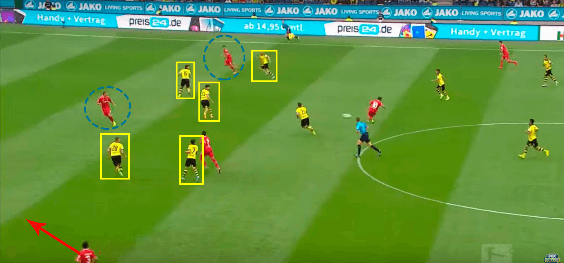
This is one of the weakest points of this team as they struggle to contend with counterattacks of the opposition, when its defensive system fails or loses the ball.
Final Comparison
Bayern München
- Long Possession
- Amplitude offensive
- Pressure
- Short pass combination game
- Always looking for numerical superiority
- Inward Diagonals
Borussia Dortmund
- Verticality and speed
- Upfront Game
- Lateral projection
- Opening constant passing lanes
- Triangulations
- Use of blind spots and depth.
Written by Nicolas Pernigotti
[contentcards url=”https://outsideoftheboot.com/2015/07/24/tactical-philosophy-thomas-tuchel/” target=”_blank”]
- Tactical Analysis: Juventus 2-2 Bayern Munich | Allegri’s 4-4-2 and critical change of pace in second half - February 29, 2016
- Tactical Analysis: Monchengladbach 1-3 Dortmund | Effective counter attacks work for Dortmund - January 28, 2016
- Tactical Analysis: River Plate 0-3 Barcelona | Barca’s enterprising play too much for River - December 28, 2015




















































